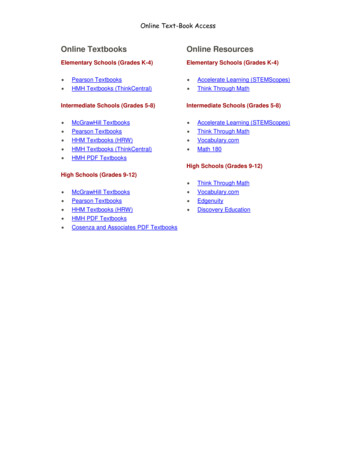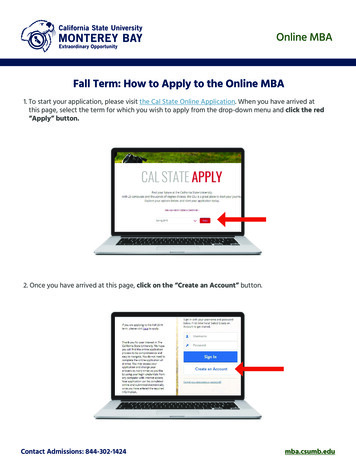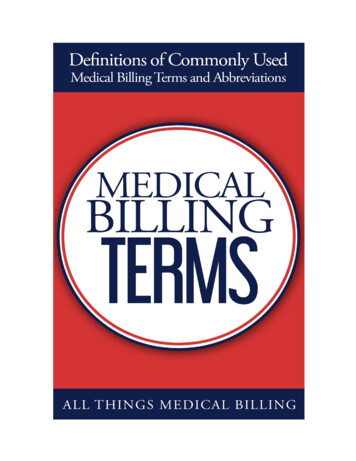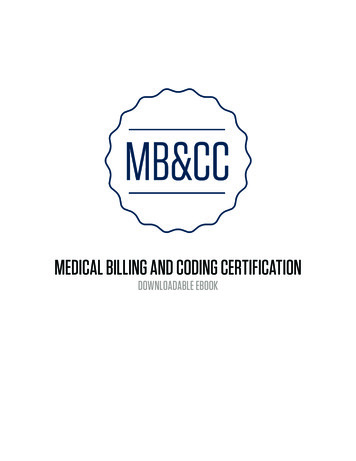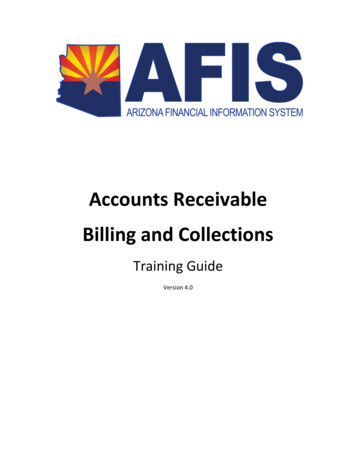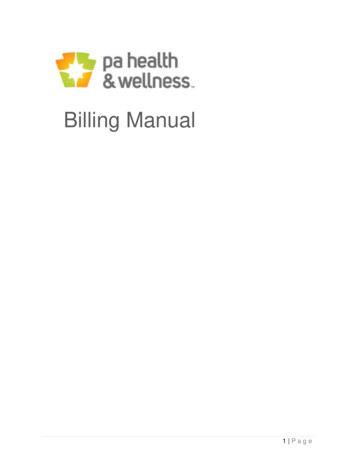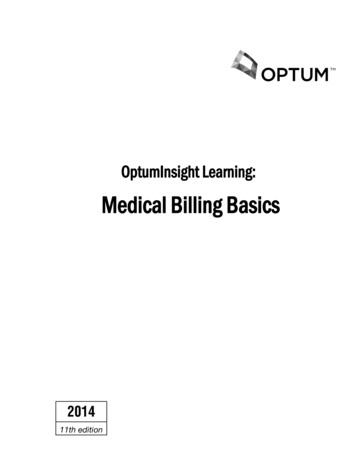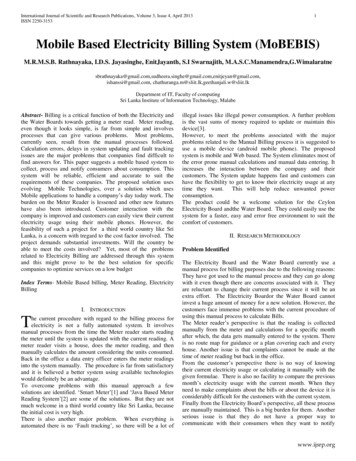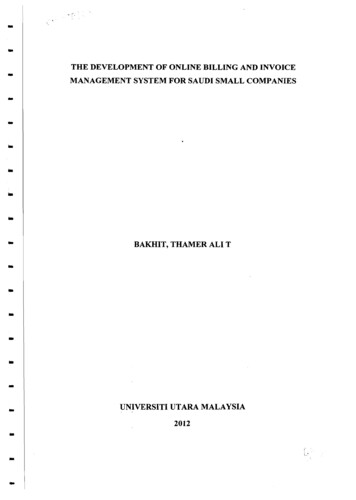
Transcription
THE DEVELOPMENT OF ONLINE BILLING AND INVOICEMANAGEMENT SYSTEM FOR SAUDI SMALL COMPANIESBAKHIT, THAMER ALI T.UTARA MALAYSIAUNIVERSITI2012
THE DEVELOPMENT OF ONLINE BILLING AND INVOICEMANAGEMENT SYSTEM FOR SAUDI SMALL COMPANIES.A Thesis submitted to the College of Arts and Sciences in partialfulfillment of the requirements for the degree Master of Science(Information and Communication Technology),Universiti Utara MalaysiaBYBAKHIT, THAMER ALI TBAKHIT THAMER ALI T, 2012. All rights reserved.
KOLEJ SASTERA DAN SAINS(College of Arts and Sciences)Universiti Utara MalaysiaPERAKUAN KERJA KERTAS PROJEK(Certificate of Project Paper)Saya, yang bertandatangan, memperakukan bahawa(I, the undersigned, certifies that)BAKHIT, THAMER ALI T18050201Icalon untuk Ijazah(candidate for the degree on MSc. llnformation & Communication T e c h n o l o w lItelah mengemukakan kertas projek yang bertajuk(has presented his/herproject of the following title)IITHE DEVELOPMENT OF ONLINE BILLING AND INVOICEMANAGEMENT SYSTEM FOR SAUDI SMALL COMPANIESIIseperti yang tercatat di muka surat tajuk dan kulit kertas projek(as it appears on the title page and front cover ofproject)bahawa kertas projek tersebut boleh diterima dari segi bentuk serta kandungandan meliputi bidang ilrnu dengan memuaskan.(that this project is in acceptable fonn and content, and that a satisfactoryknowledge of thefield is covered by the project).Nama Penyelia(Name of Supervisor) : ASSOC. PROF. ABD GHANI GOLAMDINTandatangan(Signature)Tarikh (Date, :Nama Penilai(Name of Evaluator) : MR. MUHAMMAD SHAHBANI ABU BAKARI
PERMISSION TO USEIn presenting this project of the requirements for a Master of Science in Information andCommunication Technology (MSc. ICT) from Universiti Utara Malaysia, I agree that theUniversity library may make it freely available for inspection. I further agree thatpermission for copying of this project paper in any manner, in whole or in part, forscholarly purposes may be granted by my supervisor or in their absence, by the Dean ofGraduate School. It is understood that any copying or publication or use of this project orparts thereof for financial gain shall not be allowed without my written permission. It isalso understood that due recognition shall be given to me and to Universiti Utara Malaysiafor any scholarly use which may be made of any material from my project paper.Request for permission to copy or make other use of materials in this project, in whole or inpart, should be addressed to:Dean of Graduate School.'Universiti Utara Malaysia06010 SintokKedah Darul AmanMalaysia
ABSTRACTInvoicing and billing application for different business purposes helps mainly the serviceproviders and freelancers to manage, send professional invoices online, and track its status.Generally, all the small companies in Saudi Arabia facing a various issues for managingand tracking the invoice status of customers, which mostly back to the lacks of adaptingnew technology in these companies. One of these lacks is tracking the bills status for adetinite projects'. Therefore, this research intends to design and develop an online billingand invoice management system to expenses effortlessly and saves both time and money onthe employees in the Saudi small companies (Sepco Company). The propose system intendto provide a digital tracking of the time spend on projects and send invoices directly toclients. An evaluation was conducted among 30 employees and business administrators atSepco Company to perceive their opinion towards the system ease of use, usefulness, andsatisfaction. The result revealed that the proposed system gained a satisfactory level amongthe participants.
ACKNOWLEDGEMENTSPraise to Allah for his guidance and blessing for giving me the strength and perseverance tocomplete this project. I would foremost like to thank my parents and my wife, for providingme with the opportunity to pursue my goals and for their love and affection, which hashelped me through the most trying times. Equal gratitude goes out to my siblings andbrothers. I would like to thank my supervisors: Assoc. Prof. Abd Ghani Golamdin and Dr.Muhamad Shahbani Abu Bakar" for their guidance and constant motivation that hasenabled me to complete my project work. Moreover, I would also like to thank them for theopportunities that they have made available to me."BAKHIT THAMER ALI T"January 2012
.TABLE OF CONTENTS.Page NumPERMISSION TO USEABSTRACTACKNOWLEDGEMENTSTABLE OF CONTENTLIST OF TABLESLIST OF FIGURESCHAPTER ONEINTRODUCTION1.1 Introduction1.2Problem Statement1.3 Research Objectives1.4 Research Question1.5 Research Scope1.6 Significant of Study1.7Research Structure1.8 SummaryvCHAPTER TWOLITERATURE REVIEW2.1 Introduction2.2 The Origin of Content Management System
2.3 Database Management System (DBMS)2.4 Online Billing System2.5 Content Management in Billing Systems2.6 Related Work2.7 Summary-ICHAPTER THREERESEARCH METHODOLOGY3.1 Introduction3.2 Awareness of the problem3.3 SuggestionIm 3.4 Development3.4.1 Analysis and Quick Design3.4.2 Prototype Cycle3.4.3 Testing3.4.4 Implementation3.5 Evaluation3.5.1 Research Population and Sample3.5.2 Instrumentatiqn,3.5.3 Reliability3.5.4 Data collection and Analysis3.6 Conclusion3.7 Summary
CHAPTER FOURANALYSIS AND DESIGN OF OBIS4.1 Introduction4.2 OBIS Requirements4.2.1 Functional Requirements4.2.2 Non-Functional Requirements4.3 Use Case Diagram4.4 OBIS Sequence and Collaborative Diagram4.4.1 Login Sequence and Collaborative Diagram4.4.2 Search Sequence and Collaborative Diagram4.4.3 Manage Clients Sequence and Collaborative Diagram4.4.4 Manage Invoice Sequence and Collaborative Diagram4.4.5 Manage Inventory Sequence and Collaborative Diagram4.4.6 Manage Payment Sequence and Collaborative Diagram4.4.7 View Report Sequence and Collaborative Diagram4.5 User Interface4.6 PKP Code4.7 SummaryCHAPTER FIVEEVALUATION OF OBIS5.1 Reliability5.2 Descriptive Statistic5.3 Correlation Test5.4 Summary
CHAPTER SIXCONCLUSION6.1 Introduction6.2 Problems and Limitations6.3 Recommendations6.4 ConclusionREFERENCESAppendix AVII
LIST OF TABLESTable 3.1 : Hardware and Software Requirements39Table 4.1 : OBIS Functional Requirement45Table 4.2: Non-Functional Requirements48Table 5.1: Reliability Statistic for all OBIS75Table 5.2: Descriptive Statistic for OBIS76Table 5.3: Correlation Test Result.
LIST OF FIGURESPage NumFigure 1.1 : OBIS Process7Figure 2.1 : Example of Billing Management System16Figure 2.2: Content Management in Organisations17Figure 2.3: Basic Web Architecture20Figure 2.4: Infonova Billing system process21Figure 2.5: Conceptual architecture of the billing engine22Figure 2.6: The Costmedia CMS Billing System23Figure 2.7: Porta Billing template engine24Figure 2.8: collection time25Figure 2.9: eInvoice Components26Figure 2.10: e-invoicing System components27Figure 2.1 1: The Internet Billing System28Figure 2.12: Online Billing and Payment system29Figure 2.13: Diagram Context for the Payment and Invoice System30Figure 3.1 : General Methodology32,DetailsFigure 3.2: Research Method33Figure 3.3 Conceptual Framework of OBIS34Figure 3.4: RAD Development Phases35Figure 3.5: Context Diagram of the OBIS37Figure 3.6: Level-0 Diagram of the OBIS37Figure 4.1 : Use Case Diagram for OBIS50Figure 4.2: Login Sequence Diagram52Figure 4.3: Login Collaborative Diagram53Figure 4.4: Search Sequence Diagram54Figure 4.5: Search Collaborative Diagram55,
Figure 4.6: Manage Client Sequence DiagramFigure 4.7: Manage Client Collaborative DiagramFigure 4.8: Manage Invoice Sequence DiagramFigure 4.9: Manage Invoice Collaborative DiagramFigure 4.10: Manage Inventory Sequence DiagramFigure 4.1 1: Manage Inventory Collaborative DiagramFigure 4.12: Manage Payment Sequence DiagramFigure 4.13: Manage Payment Collaborative DiagramFigure 4.14: View Reports Sequence DiagramFigure 4.15 : View Reports Collaborative DiagramFigure 4.16: OBIS Login PageFigure 4.17: OBI Home PageFigure 4.1 8: Manage Client PageFigure 4.19: Manage Invoice PageFigure 4.20: Search PageFigure 4.2 1 : Manage Payment PageFigure 4.22: Manage Inventory Items PageFigure 4.23: View Reports Page
CHAPTER 1INTRODUCTIONThis chapter mainly focuses on introducing the research aims, background, and thecurrent issues towards the billing and invoice management systems and itsperformance among different business companies. In addition, this chapter addressesthe research solutions along with the relevant research questions in terms of designingand developing a new billing management system, which involves both technical andpage optimization test. Finally, research process is introduced in order.1.1 IntroductionE-business (also referred to as Web-based management systems) is defined as a newcontext for business where a large amount of information and services describe the ecommerce practices in different business organizations (Welsh, Wanberg, Brown, &Simmering, 2003). This kind of service obtains a better representation of informationbased on deploying different web tools and techniques for certain purposes, whichcould be seen as a blessing: plenty of information readily available just a click away(Tang & McCalla, 2005). Even so, it could equally be seen as an exponentiallygrowing nightmare, in which unstructured information chokes the end users withoutproviding any articulate details about the billing contents. An example of theseintegrations is data mining, which was used to simplify the existing problems with ebusinesses (Dredze, et al., 2007), which can be understood not just as a collection of
The contents ofthe thesis is forinternal useronly
ReferencesAustria, T. (2009). Infonova Billing System for an All IP Service Platform. InfonovaBillingSystemRetrieved21-10,201 1,fromhttp://www.ministerialkonrrress.de/0302 CA EN TelekomAustria final web.pdfBonk, C., Wisher, R., & Lee, J. (2004). Moderating learner-centered e-learning:Problems and solutions, benefits and implications. Online collaborativelearning: Theory and practice, 54-85.Brandmeier, R. A., Hain, S., & Rupp, F. (201 1). Emerging Markets Case StudiesCollection. Emerald.Brusilovsky, P., Sosnovsky, S., & Shcherbinina, 0. (2005). User modeling in adistributed e-learning architecture. User Modeling 387-391.Center, N. F. (2003). Internet Billing System (IBIL). 2011(19-Sep). Retrieved .pdfChou, Y., Lee, C., & Chung, J. (2004). Understanding m-commerce payment systemsthrough the analytic hierarchy process. Journal of Business Research, 5 7(12),1423-1430.Cohen, A. D. (1999). Strategies in learning and using a second language. Strategies,3(4).Cossentino, M., Burrafato, P., Lombardo, S., & Sabatucci, L. (2010). Introducingpattern reuse in the design of multi-agent systems. Agent Technologies,Infrastructures, Tools, and Applications for E-Services, 107- 120.Costa, G., & Silva, N. (2010). Knowledge versus content in e-learning: A-philosophical discussion. Information Systems Frontiers, 1 15.Costmedia CMS Billing System. (2008).Retrieved 12-11, 201 1, fromhttp://www.costmedia.com/costmedia brochure/CostmediaCMS Billing Bureau.pdfCuerda, X., & Minguillbn, J. (2005). Introducci6n a 10s sistemas de gestion decontenidos (CMS) de c6digo abierto. Mosaic, 36.Dredze, M., Blitzer, J., Talukdar, P., Ganchev, K., Graca, J., & Pereira, F. (2007).Frustratingly hard domain adaptation for dependency parsing. Paperpresented at the CoNLL Shared Task Session of EMNLP-CoNLL.
Driscoll, M. (1994). Psychology of Learning for Instruction: Allyn & Bacon, ADivision of Paramount Publishing, Inc., 160 Gould Street, Needham Heights,MA 02 194.eInvoice. (2009). Invoice Management via the Cloud to Reduce Efforts and EnsureCompliance.Retrieved17-10,201 o eInvoice.pdfFerniindez-Caballero, A., Lopez-Jaquero, V., Montero, F., & Gonzalez, P. (2003).Adaptive Interaction Multi-agent Systems in E-learnin@-teachingon theWeb. Web Engineering, 359-366.Ferrer, N., & Alonso, J. (2010). Content Management for E-Learning: SpringerVerlag.Garro, A., & Palopoli, L. (2010). An xml multi-agent system for e-learning and skillmanagement. Agent Technologies, Intastructures, Tools, and Applications forE-Services, 283-294.Gay, L. R., & Airasian, P. W. (2000). Educational research: Competencies foranalysis and application: prentice Hall Upper Saddle River, NJ.Gregg, D. (2007). E-learning agents, Learning Organization, The, 14(4), 300-3 12.Harel, I., & Papert, S. (1991). Constructionism: Ablex Publishing.Hislop, D. (2005). Knowledge management in organizations: A critical introduction:Oxford University Press London.Imitola, J., Raddassi, K.; Park, K., Mueller, F., Nieto, M., Teng, Y., et al. (2004).Directed migration of neural stem cells to sites of CNS injury by the stromalcell-derived factor. 1 /CXC chemokine receptor 4 pathway. Proceedings of the,National Academy of Sciences of the United States of America, 101(52),18117.Jaap, N., & Charles, B. (2010). E-invoicing: Gilbert Lichter (EBA) and ChielLiezenberg (Innopay).Jacobson, M., & Wilensky, U. (2006). Complex systems in education: Scientific andeducational importance and implications for the learning sciences. Journal ofthe Learning Sciences, 15(1), 11-34.John, F., & Wallen, N. E. (1993). How to design and evaluate research in education:McGraw-Hill New York.Kanteev, M., Minakov, I., Rzevski, G., Skobelev, P., & Volman, S. (2007). Multiagent meta-search engine based on domain ontology. Paper presented at the
2nd international conference on Autonomous intelligent systems: agents anddata miningKotzab, H. (2005). The role and importance of survey research in the field of supplychain management. Research Methodologies in Supply Chain Management,125-137.Lowe, D. (2003). Web system requirements: an overview. Requirements Engineering,8(2), 102-113.Maier, R. (2007). Knowledge management systems: Information and communicationtechnologiesfor knowledge management: Spri
2.4 Online Billing System 2.5 Content Management in Billing Systems 2.6 Related Work 2.7 Summary - CHAPTER THREE I RESEARCH METHODOLOGY 3.1 Introduction 3.2 Awareness of the problem 3.3 Suggestion I 3.4 Development m 3.4.1 Analysis and Quick Design 3.4.2 Prototype Cycle 3.4.3 Testing 3.4.4 Implementation 3.5 Evaluation

